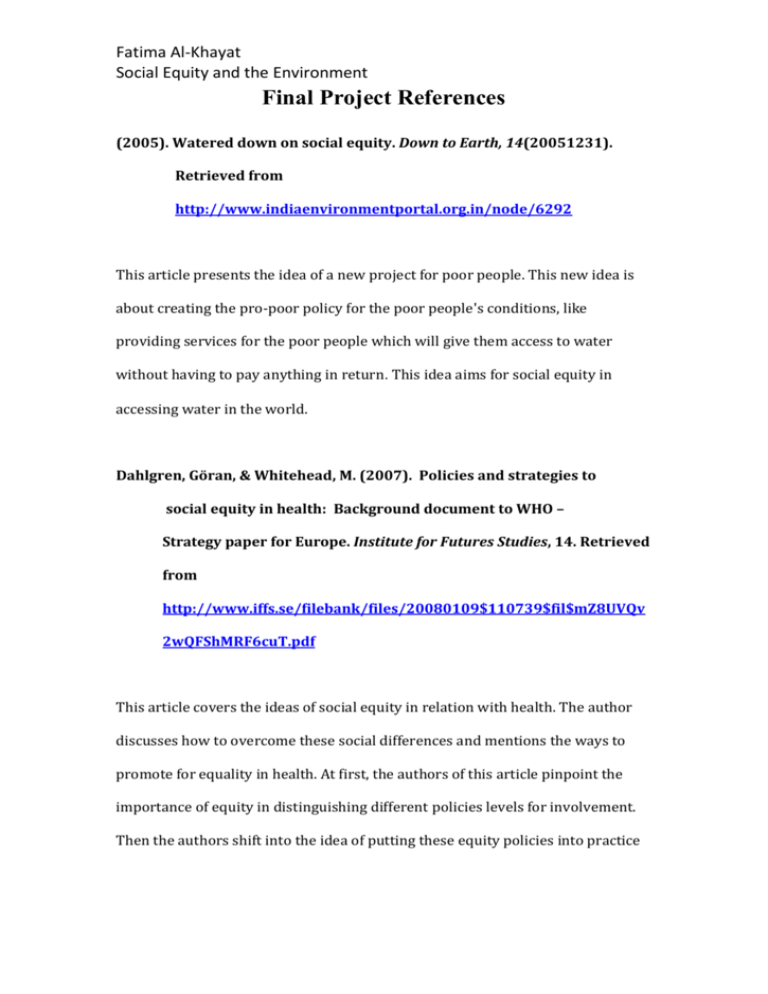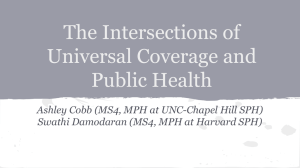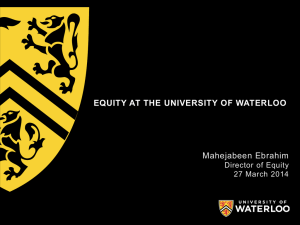Fatima Al
advertisement

Fatima Al-Khayat Social Equity and the Environment Final Project References (2005). Watered down on social equity. Down to Earth, 14(20051231). Retrieved from http://www.indiaenvironmentportal.org.in/node/6292 This article presents the idea of a new project for poor people. This new idea is about creating the pro-poor policy for the poor people's conditions, like providing services for the poor people which will give them access to water without having to pay anything in return. This idea aims for social equity in accessing water in the world. Dahlgren, Göran, & Whitehead, M. (2007). Policies and strategies to social equity in health: Background document to WHO – Strategy paper for Europe. Institute for Futures Studies, 14. Retrieved from http://www.iffs.se/filebank/files/20080109$110739$fil$mZ8UVQv 2wQFShMRF6cuT.pdf This article covers the ideas of social equity in relation with health. The author discusses how to overcome these social differences and mentions the ways to promote for equality in health. At first, the authors of this article pinpoint the importance of equity in distinguishing different policies levels for involvement. Then the authors shift into the idea of putting these equity policies into practice Fatima Al-Khayat Social Equity and the Environment and action. Furthermore, the authors reach to the point of discussing health public policies and implementation of an equity in health policy. Paehlke, R. (2003). Democracy's dilemma: Environment, social equity, and the global economy. United State of America, USA: Massachusetts Institute of Technology. Retrieved from http://books.google.com/books?id=bnFHRwk4O6IC&printsec=fro ntcover&dq=Democracy%27s+Dilemma:+Environment+Social+Eq uity+and+the+Global+Economy&hl=ar#v=onepage&q=&f=false This book focuses on the reality of global economy, pointing out that it’s more complex and dynamic than thought. Also, the author presents a plan which he refers to as "first-step plans" which is solution about achieving balances and changing the idea about the function of the economy, that it doesn't guarantee better live, nor communities and societies and neither a better social equity between everyone. In addition, the author discusses the consequences of "democracy’s dilemma" in different areas for instance. Furthermore, he also encourages for a global economic integration which is the solution to call for effective democracy. Keck, M. (1995). Social equity and environmental politics in Brazil: Lessons from the rubber tappers of acre. Comparative Politics, 27(4). Retrieved from http://www.jstor.org/stable/422227?seq=1 2 Fatima Al-Khayat Social Equity and the Environment This article discusses how environmental when defined as an issue helps into changing political framework of disagreement. The author argues how the "rubber tappers’ struggle in Brazil" helped achieving two accomplishments which are creating the right idea about social equity and environmental protection on one hand. And on the other hand he argues how the Brazil’s local condition helped (resources from environmentalists' campaign) in shaping the development movements in order to achieve that equity and environmental protection. John, D. & Catherine T. Macarthur Foundation, Initials.(n.d.).Key issues: Social stability. In Population, Consumption & The Environment. Retrieved from http://www.pcebase.org/issues/index.asp?aid=2 This article argues that environment’s condition it’s not just a function of population but it’s a function of the characteristics that social communities possess depending on the way the population is organized. It also argues for the stability of the social situation, that if it’s stable situation it creates a better environment and a better sense of the using resources, while if the situation was unstable which is the result of in-migration and other actions, create the worse environmental conditions as resources and ecological health shrink, the article supports this argument by examining the situation of India. In addition to that it argues that more researches and studies are needed. 3 Fatima Al-Khayat Social Equity and the Environment Ekbom, A., & Bojö, J. (1999). Poverty and environment: Evidence of links and integration into the country assistance strategy process. The World Bank, Africa Region, Environment Group, 4. Retrieved from http://151.1.187.213/Assets/8/20040506110148_10-3-36-111.pdf The purpose of this article is to show connection between poverty and environment and how are they related. The 2 authors in this article argue about how environment and poverty influences on each other, by supporting this argument with some reference or evidence from poor countries, like Ghana. The authors argue that the rich people, the one with the high income causes high levels of pollution, and the poor people are the main victims of this pollution or any other environmental threats, they are the ones who are affected the most. In addition to that, the authors present some good examples from existing CASs and PAs of country-specific poverty-environment interactions that supports his argument. John D. & Catherine T. Macarthur Foundation, Initials. (n.d.). Policy implications: Social stability. In Population, Consumption & The Environment. Retrieved from http://www.pcebase.org/policy/index.asp?aid=7 This article argues that effective policies are needed to be implemented regarding the social and the environment stability. It shows how the changes in 4 Fatima Al-Khayat Social Equity and the Environment population influences the allocating resources processes, where resources allocating processes can affect the ability of ecosystem to provide services needed for people. In addition, the article provides example of researches as an evidence to support its argument and to make it clear about the relationship between human (population size, migration) and nature. Yi, H., Bruce, J., & Haites, E. (1996). Climate change 1995: Economic and social dimensions of climate change. New York, NY: Press Syndicate of the University of Cambridge. Retrieved from http://books.google.com/books?hl=en&lr=&id=1BEjH8IPF8cC&oi=fnd &pg=PP11&dq=social+equity+and+climate+change&ots=RyY6T0aOzd& sig=6rUvq_5ruzvqq1IoekbPmpkAhwA#v=onepage&q=social%20equity %20and%20climate%20change&f=false The authors of this book basically are arguing about the climate change and the huge impact and influences it has on social equity and economy and how to implement the "Framework Convention" on climate change. They are arguing about equity and social consideration being the central discussions of steps to be taken. They also present the consequences and the cost the climate change has on different social levels. The authors hope that through this argument it will help countries to develop appropriate and effective responses to climate change. Blore, I. (1999). Poor people, poor services: The future of urban 5 Fatima Al-Khayat Social Equity and the Environment services as seen through 50 years of debate in public administration and development and its predecessors. Public Administration & Development, 19(5), 453-465. Retrieved from https://vpn.qatar.cmu.edu/+CSCO+dh756767633A2F2F6365626468726 6672E687A762E70627A++/pqdweb?index=57&did=405202411&SrchM ode=1&sid=1&Fmt=10&VInst=PROD&VType=PQD&RQT=309&VName=P QD&TS=1256076818&clientId=3259 This article argues about the future of human being, that it is in the hand of the cities and the government actions, like providing services, health services and public transportation. It argues how the services would be in the upcoming years, and how these services are likely to be for poor people (is it available for them? Can they afford it?! ). This article pin points the need to view present means to manage the environment of poor people and poor countries, how to balance it and how to achieve equality. Victora, C., Wagstaff, A., Schellenberg, J., Gwatkin, D., & Claeson, M., & Habicht, JP. (2003). Applying an equity lens to child health and mortality: More of the same is not enough. The Lancet, 362. Retrieved from http://www.who.int/child_adolescent_health/documents/pdfs/lancet_ child_survival_equity_lens.pdf 6 Fatima Al-Khayat Social Equity and the Environment The authors argue about the gaps in children mortality between the social class, between rich and poor countries and this wide gap is getting bigger. Moreover, they argue that the poor children have a high percentage to be exposed to health risks, because of poverty, malnutrition and the poor dangerous environment they are living in, which is the reason behind why poor children die earlier. Some of the evidences that are provided to support this argument are the child survival in India. The article also advocates for actions to stop children from dying and to shrink the gap between poor people and rich people, until it’s a closed gap. Chiu, R. (2002). Social equity in housing in the Hong Kong Special Administrative Region: A social sustainability perspective. Sustainable Development, 10(3), 155-162. Retrieved from http://proquest.umi.com/pqdweb?did=349513381&sid=2&Fmt=10&clie ntId=3259&RQT=309&VName=PQD This article argues about the policy that is implemented in Hong Kong which deals with housing and the condition of the housing market, which have gone under huge striking changes since1997. The new government takes housing as a requiring resolution for the main social issue. In addition, this article examines the policy of housing whether it had been an effective policy or not (whether the housing distribution had reached a level of equitable). The concept of equity is considered as important factor for obtaining the social sustainability in this article. 7 Fatima Al-Khayat Social Equity and the Environment Cattell, V. (2001). Poor people, poor places, and poor health: The mediating role. Social Science & Medicine, 52, 1501-1516. Retrieved from http://cc.kmu.edu.tw/~lishli/Poor%20people,%20poor%20places,%20a nd%20poor%20health.pdf Cattell argues in this article about the relation between poverty and exclusion, how it’s being like a dynamite. He also argues about the relation between the health and well being how they influence each other and also how neighborhood has a huge influence on the "social networks". Throughout his article, Cattell addresses issues by raising questions such as poverty, place in relation with health, and how these factors are playing roles into identifying the social network and environment. Furthermore, Cattell discusses the environment that the poor people have to cope with and how that had an impact on their life, in a bad way. Cattell supports his argument on qualitative researches which was based on case studies and depth interviews with residents. Knack, S. & Keefer, P. (1998). Why don't poor countries catch up?: A cross-national test of an institutional explanation. Economic Inquiry, XXXV, 590-602. Retrieved from http://pdf.dec.org/pdf_docs/Pnabr230.pdf The authors of this article are arguing about the reasons that are enabling the poor countries from catching up and developing. The authors present the idea 8 Fatima Al-Khayat Social Equity and the Environment that the growing gap between the rich and the poor countries oppose the hypothesis of the development of poor countries. They also put the lights on another obstacle which they identified as the “institutional environment”; which include the inadequate legal, politics, etc… and having some deficiencies. They also analyze several of indicators that include corruption in these poor countries, and the security of property right which help to study the hypothesis about the poor countries’ ability to develop. Wagstaff, A. (2002). Poverty and health sector inequalities. Bull World Health Organ, 80(2), 97-105. Retrieved from http://www.scielosp.org/scielo.php?pid=S004296862002000200004&script=sci_arttext&tlng=en doi: 10.1590/S0042-96862002000200004 Wagstaff argues in this article about the cycle of health and poverty, how these to terms are related to each other and how do they influence one another and influence the environment. He argues in this article that poor countries will be facing more health problems and that the poor people will exposed to a number of dangerous disease. He supports his argument by evidence biased on health differences between the poor people and rich people, and mentioning the causes that leads to such an issue. In addition to that, the author presents the idea about poor people that are paying to have a health care and how is that difficult to achieve. Furthermore, he discusses about the impact that the programs and the policies on health sector inequalities have on poor countries and people. The 9 Fatima Al-Khayat Social Equity and the Environment author advocate that more hard work and studies are needed about "health sector inequalities" and public policy regarding the health sector in order to fill the gap about our own knowledge on how to overcome this cycle of poverty and ill-health. (2009). MTSU researcher says 'green economy' investment can reduce poverty in the region & benefit the environment. The Tennessee Tribune, 20(35), 11. Retrieved from http://proquest.umi.com/pqdweb?did=1868705851&sid=3&Fmt=3&clien tId=3259&RQT=309&VName=PQD This article argues about the new idea called “Green Economy”. This is an idea of Dr. Sekou Franklin that he came up with about a new way system investment that will have a huge impact such as creating a millions of jobs and creating a broader public transportation. This idea was proofed by a 12- stage study. This kind of system will ensure a decrease in poverty by decreasing the number of unemployment people which will benefit the economy and also the environment will have benefits out from this system because the number of people in cars has reduced (gas and oil emission from cars that pollute the environment). 10





